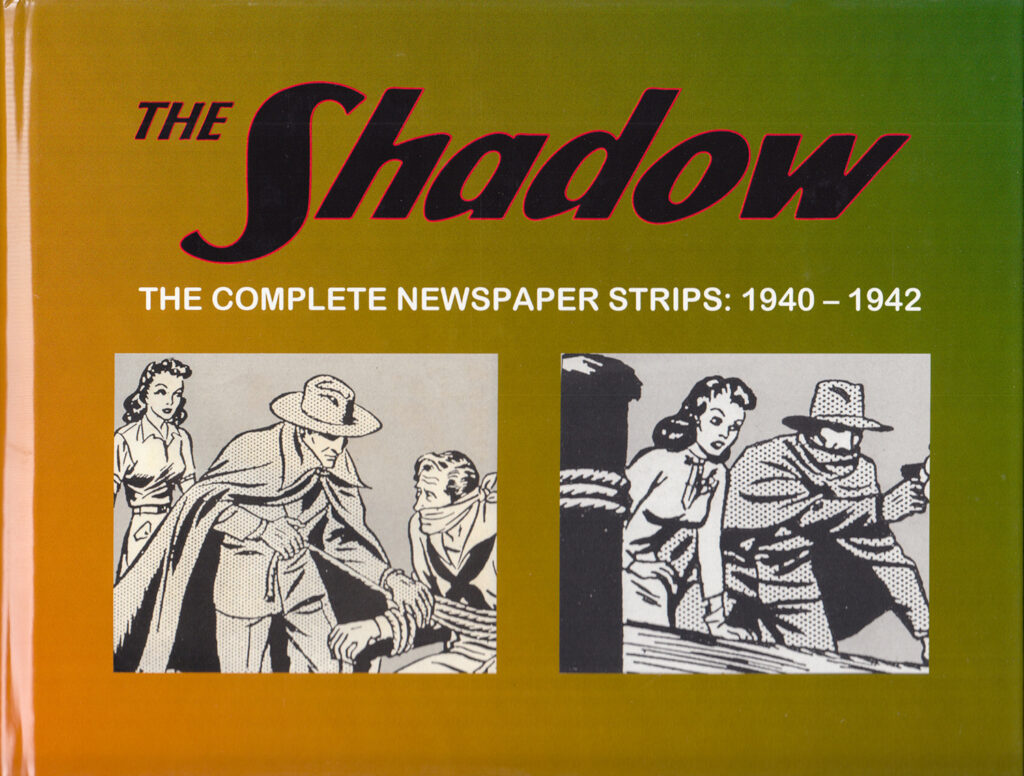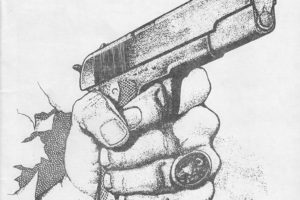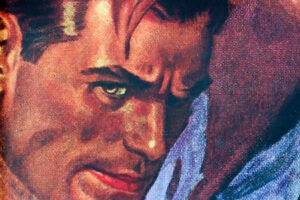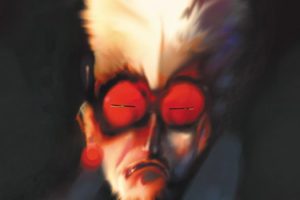 Greene was also the sole artist for Shadow Comics at the same time he did the newspaper strip. And in a few cases, the storylines and artwork from the strip was re-worked as comicbook stories. After 1942, he shared work on Shadow Comics until mid-1943. And he also did some interior work on The Shadow pulp as well.
Greene was also the sole artist for Shadow Comics at the same time he did the newspaper strip. And in a few cases, the storylines and artwork from the strip was re-worked as comicbook stories. After 1942, he shared work on Shadow Comics until mid-1943. And he also did some interior work on The Shadow pulp as well.
I should point out that the strip was a daily-only strip. There was no Sunday section. That was not unusual during the time, as many strips where either daily only, Sunday only, or if they had both often had totally separate storylines. Those some merged the two. This was done in part because some papers only wanted one or the other.
I had never read a complete set of the stories, and wasn’t even sure of all the story arcs that existed. There were two comicbook series that reprinted the strip, but I wasn’t sure if they were complete. They aren’t.
The first by Eternity Comics in 1988-89 only did the first nine of 14 story arcs in 13 issues of Crime Classics. And Avalon Communications in 1999 did five-story arcs in eight issues of Pulp Action.
Anthony Tollins‘s Sanctum Books was going to do a complete reprint of the strip, but like a few other such projects, it never saw the light of day due to Conde Nast pulling the license from them. Who knows when or if we’ll see an official reprint of them?
Thankfully, a fan group was able to pull together a complete set and reprint them, along with some additional materials, in a hardback collection titled The Shadow: The Complete Newspaper Strips: 1940-1942. Only 100 were made and as this collection isn’t authorized, I’m not comfortable stating who did it. But it’s a pretty good collection with info on the strip, on Greene, and some additional material.
The story arcs are:
- “Mystery of the Sealed Box” (June 17-Aug. 10, 1940)
- “The Shadow in his Sanctum” (Aug. 12-Sept. 21, 1940)
- “The Shadow vs. Hoang Hu” (Sept. 23-Nov. 2, 1940)
- “The Shadow on Shark Island” (Nov. 4, 1940-Jan. 25, 1941)
- “The Shadow vs. The Bund” (Jan. 27-April 19, 1941)
- “The Shadow vs. The Golden Master” (April 21-July 26, 1941)
- “The Darvin Fortune” (July 28-Oct. 11, 1941)
- “The Adele Varne Mystery” (Oct. 13-Nov. 22, 1941)
- “The Shadow and Professor Scorpio” (Nov. 24-Dec. 13 1941)
- “The Shadow and the Gray Ghost” (Dec. 15, 1941-Jan. 10, 1942)
- “The Star of Delhi” (Jan. 12-31, 1942)
- “The Earthquake Machines” (Feb. 2-March 28, 1942)
- “The Return of Althor” (March 30-May 23, 1942)
- “The Cliff Castle” (May 25-June 20, 1942)
In reading over the strips, I was not sure if storylines were based on original pulps, but I now know several are due to the information on the comicbook stories and my own attempts at research.
I did find some interesting aspects in the strip. The strip seems more based on the pulp version of The Shadow than the radio show, though it simplifies things by having The Shadow be Lamont Cranston. This is understandable as Gibson wrote them, and he was not involved with the radio show. Plus in many, he clearly recycled pulp stories, which I understand he also did in the comics. Hey, it’s not stealing when you steal from yourself!
The Shadow either appeared/left the storyline in an autogyro or sometimes driven by Shrevy. None of his other agents show up, though in one story Myra Reldon and Dr. Roy Tam appear, but Myra is working for Dr. Tam and neither of them are agents of The Shadow. And in this one, The Shadow is called Ying Ko by those in Chinatown.
Starting with the fifth story, Margo Lane appears, but is Cranston’s secretary and not an agent and is not aware (but suspects) that Cranston is The Shadow until he reveals this to her later on. Also interesting is that with the 12th story, The Shadow is able to turn himself invisible by hypnosis, something I suspect was also used in the comics around the same time. In a few strips, Commissioner Weston and Inspector Cardona appear.
So let’s take a closer look at the stories.
The first one, “Mystery of the Sealed Box” is based on The Shadow pulp story “The Sealed Box” (Dec. 1, 1937). This one has The Shadow visit a friend (via autogyro) who is murdered before he is able to arrive. The victim has a sealed box with evidence of corruption in town. Many are after the box, and there are a lot of suspects before it’s all settled. I found it strange that at one point criminals capture The Shadow but don’t bother to check on who he is. This was re-used in the ninth Shadow Comics in March 1941.
The next story, “The Shadow in His Sanctum,” may seem to have a strange title, but it’s due to that being the text in the first box. He is on the radio with an unknown person (Burbank?). A criminal named Kalgar, who operates out of a castle(!) is trying to stop or take various inventions like a sleep gas and a new plane. Shrevy appears, though The Shadow leaves by autogyro.
In “The Shadow vs. Hoang Hu,” The Shadow goes up against an oriental foe: Hoang Hu. But he’s not who he seems. I thought it interesting that some of his poses are based on Shiwan Khan. This is the story with Myra Reldon and Dr. Tam. This story was adapted for the 10th Shadow Comics in May 1941. I believe it’s based on “The Golden Pagoda” from The Shadow pulp (March 1, 1938) where the villain was named Li Hoang.
Next, “The Shadow on Shark Island” starts off with Cranston in the Cobalt Club, shown as the gentleman’s club. It is not a night club. He heads to the Caribbean to deal with a situation on Shark Island involving a crook known only as The Daggar, while informing the FBI. This one was adapted for the 12th Shadow Comics in September 1941.
Margo Lane shows up in “The Shadow vs. The Bund” as Cranston’s secretary. I found it funny that The Shadow rescues her and drives her in his car with his face pretty much exposed, but she doesn’t recognize that Cranston is The Shadow. This one is a long story, with The Shadow fighting against the Bund and their takeover of the “ghost fleet.” It’s adapted in two issues of Shadow Comics. The first part in vol. 2, #1 (November 1941) and vol. 2, #3 (March ’42).
In an adaption of the first two Shadow novels dealing with Shiwan Khan (Sept. 15 and Dec. 1, 1939), we get “The Shadow vs. The Golden Master,” which is The Shadow’s first meeting with Shiwan Khan. Now this one was adapted into Shadow Comics vol. 2, #4 (May 1942) and the second Shadow Better Little Book, which I previously have reviewed, that came out in 1941. So I guess Gibson probably did that BLB (and maybe the other two). Shrevy and Commissioner Weston also appear here. The weirdest part of this is how Shiwan Khan escapes.
Next is “The Darvin Fortune,” where The Shadow helps a young man get his fortune and thwarts the con men after it. Shrevie (new spelling) plays a bigger role in this one and Commissioner Weston also appears. In “The Adele Varne Mystery,” The Shadow with the help of Shrevie and Margo, help save a young woman being targetted for death.
Next is “The Shadow and Professor Scorpio,” where The Shadow deals with a fake seance and murder. This is the last strip converted to Shadow Comics, in v2 #5 (July 1942).
We get two stories I know definitely were adapted from pulp stories. First up, “The Shadow and the Gray Ghost” (Dec. 15, 1941-Jan. 10, 1942), based on The Gray Ghost (May 1, 1936), has The Shadow go up against that villian. Next, “The Star of Delhi” (Jan. 12-31, 1942) is based on the novel of the same name (July 1, 1941) has criminals after the gem.
Moving toward the end, we get a trio of interconnected stories. And finally have The Shadow turning invisible, done in a washtone. “The Earthquake Machines” (Feb. 2-March 28, 1942) has The Shadow go up against a sinister scientist named Althor, who has a mountain lair with a lightning machine and other devices that produce earthquakes. Also introduced is a young man named Skeet Harley who gets pulled into things, and Althor’s female associate Valda. At the end, The Shadow blows up Althor’s lair, but is that the end?
Well, the next story is “The Return of Althor” (March 30-May 23, 1942), and Skeet and Valda are along for the ride, though Valda has switched sides and is wearing a black cat costume. Also introduced is Althor’s black panther Nagu, who becomes kind of a pet for The Shadow. At the end, Althor gets away, but The Shadow swears to stop him.
Finally, we have “The Cliff Castle” (May 25-June 20, 1942), where The Shadow is investigating a trio of deaths, all refugees. The only connection is to a Prof. Demester, who lives in a cliff castle. The Shadow has Skeet helping and also brings along Nagu. And for some reason, Valda is involving herself. Intestingly, The Shadow turns Nagu invisible by hypnosis. I wonder why Skeet and Valda were included in these stories? Was this an attempt at creating more secondary characters to increase reader interest?
I have since learned that Valda was actually added to the Shadow comicbook stories (tho not the pulps…).
If Shadow fans are able to identify if other stories are based on Shadow novels, let me know in the comments. I’m not as well read in them as I’d like to be. I tried looking for stories that seem to match.
Overall, this was an interesting collection. I wish we could get a complete reprinting of Shadow Comics from Street & Smith as they are another interesting take on the character.




Your comments